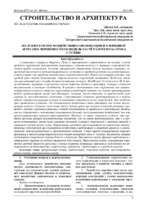| dc.contributor.author | Шалый, Е. Е. | |
| dc.contributor.author | Ким, Л. В. | |
| dc.contributor.author | Леонович, С. Н. | |
| dc.coverage.spatial | Белгород | ru |
| dc.date.accessioned | 2024-06-03T08:06:09Z | |
| dc.date.available | 2024-06-03T08:06:09Z | |
| dc.date.issued | 2018 | |
| dc.identifier.citation | Шалый, Е. Е. Железобетон при воздействии карбонизации и хлоридной агрессии: вероятностная модель расчёта-прогноза срока службы = Reinforced concrete under influence of carbonization and chloride aggression: probable model of service life calculation / Е. Е. Шалый, Л. В. Ким, С. Н. Леонович // Вестник Белгородского государственного технологического университета им. В. Г. Шухова. – 2018. – № 6. – С. 5-14. | ru |
| dc.identifier.uri | https://rep.bntu.by/handle/data/144403 | |
| dc.description.abstract | С развитием Северного Морского Пути и наращиванием нефтедобычи на шельфе сегодня проблема определения долговечности инженерных гидротехнических и портовых сооружений является крайне актуальной. Согласно официальной статистики больше половины портовых сооружений находятся в неудовлетворительном состоянии и требуют ремонта или реконструкции, в свою очередь это требует значительных капиталовложений. Опыт эксплуатации показал, что средний срок службы большинства гидротехнических сооружений составляет 30-40 лет, тогда как нормативный срок службы должен составлять минимум 50-100 лет. Сегодня около 90 % железобетонных портовых сооружений имеют дефекты бетона и арматуры, которые снижают долговечность и несущую способность. В процессе эксплуатации эти сооружения, как правило, подвергаются комплексу тяжелых агрессивных воздействий, поэтому на стадии проектирования важно предусмотреть целый ряд факторов, которые могут повлиять на фактический срок службы их железобетонных элементов. Существующие методики проектирования не в полном объеме отражают реальные условия эксплуатации гидротехнических сооружений. Это особенно ярко проявляется в районах, где одновременное воздействие таких факторов, как низкие температуры воздуха и большое число ясных дней в зимнее время при сильной солнечной радиации, приводит к резкому изменению реальных условий эксплуатации по сравнению с расчетными. Бетоны многих сооружений и конструкций испытывают большее число агрессивных воздействий, чем это предусматривается нормами проектирования. Поэтому, из выше сказанного следует, что проблема прогноза ресурса железобетонных элементов, как на этапе проектирования, так и в процессе эксплуатации, всегда была наименее изученной в теории сооружений и наиболее весомой в социально-экономическом плане. Разработана методика прогнозирования долговечности железобетонных конструкций при совместном воздействии карбонизации и хлоридной агрессии с использованием конечно-разностной и вероятностной моделей. Учтен период инициирования коррозии арматуры и период распространения для условий шельфовой зоны о. Сахалин. Выполнены полевые исследования сооружений портов Холмск и Корсаков. Произведена оценка фронта карбонизации и содержания хлоридов по глубине защитного слоя бетона. Предложена модель, позволяющая определить средний период до ремонта с учетом скорости деградации защитного слоя бетона от одновременного воздействия двух коррозионных процессов: карбонизации и хлоридной агрессии. | ru |
| dc.language.iso | ru | ru |
| dc.publisher | Белгородский государственный технологический университет им. В. Г. Шухова | ru |
| dc.title | Железобетон при воздействии карбонизации и хлоридной агрессии: вероятностная модель расчёта-прогноза срока службы | ru |
| dc.title.alternative | Reinforced concrete under influence of carbonization and chloride aggression: probable model of service life calculation | ru |
| dc.type | Article | ru |
| local.description.annotation | The problem of determining the longevity of engineering hydraulic engineering and port facilities is extremely urgent today due to the development of the Northern Sea Route and the increase in oil production is actual. According to the official statistics, more than half of the port facilities are in unsatisfactory condition and require repair or reconstruction, which in turn requires considerable capital investment. Operational experience has shown that the average service life of most hydraulic structures is from 30 to 40 years, whereas the standard service life should be at least 50–100 years. Today, about 90 % of reinforced concrete port facilities have defects in concrete and reinforcement, which reduce durability and bearing capacity. In the process of operation these structures are usually exposed to a complex of severe aggressive influences, therefore it is important to provide at the design stage a number of factors that may affect the actual service life of their reinforced concrete elements. Existing design techniques do not fully reflect the actual operating conditions of hydraulic structures. This is particularly evident in areas where the simultaneous impact of such factors is as low air temperatures and a large number of clear days in winter with strong solar radiation leads to a drastic change in the real operating conditions compared to the calculated ones. Concretes of many structures and structures experience great number of aggressive impacts than is provided for by design standards. Therefore, from the above, it follows that the problem of resource forecasting of reinforced concrete elements, both at the design stage and in the process of exploitation, has always been the least studied in the theory of structures and the most significant in the socioeconomic sense. A technique for predicting the durability of reinforced concrete structures under the combined effect of carbonization and chloride aggression using finite-difference and probability models is developed. The period of initiation of corrosion of the reinforcement and the period of propagation for the conditions of the shelf zone are taken into account. Sakhalin. Field surveys of the port facilities of Kholmsk and Korsakov have been carried out. The carbonization front and the chloride content were estimated from the depth of the protective layer of concrete. A model is proposed which allows determining the average period before repair, taking into account the rate of degradation of the protective layer of concrete from the simultaneous action of two corrosion processes: carbonization and chloride aggression. | ru |

